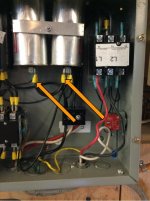My apologies in advance, because I know this has been asked before.
I've read back through quite a few thread trying to figure this out, but my lack of knowledge of electrical stuff is impeding me. I need the moron's version. sorry
sorry
BTW - I would hire someone, but this is way out in the country and I haven't been able to find anyone.
I installed a WNY 5 hp converter and motor. ran that for a while, then needed to upgrade to 10 hp. so I bought the bigger panel
10 Hp Phase Control Panel
Diagram here: Rotary Phase Converter Control Diagram
Since shipping a 10 hp motor to Canada is expensive, I sourced one locally.
10 hp, 3ph, 3450 rpm.
Hooked it all up identical to the previous one and...lo and behold ...it works!
However: my VFD's are complaining and the various front panel buttons stop working after a while.
On advice I checked the voltages, at the RPC panel: I get 235 for 2, but 260 for one.
The suspicion is that the imbalance is bothering the VFDs.
Ok, but now how do I balance this out?
Can someone please guide me?
Unfortunately, finger puppets might be necessary.
Thanks
Olaf
I've read back through quite a few thread trying to figure this out, but my lack of knowledge of electrical stuff is impeding me. I need the moron's version.
 sorry
sorryBTW - I would hire someone, but this is way out in the country and I haven't been able to find anyone.
I installed a WNY 5 hp converter and motor. ran that for a while, then needed to upgrade to 10 hp. so I bought the bigger panel
10 Hp Phase Control Panel
Diagram here: Rotary Phase Converter Control Diagram
Since shipping a 10 hp motor to Canada is expensive, I sourced one locally.
10 hp, 3ph, 3450 rpm.
Hooked it all up identical to the previous one and...lo and behold ...it works!
However: my VFD's are complaining and the various front panel buttons stop working after a while.
On advice I checked the voltages, at the RPC panel: I get 235 for 2, but 260 for one.
The suspicion is that the imbalance is bothering the VFDs.
Ok, but now how do I balance this out?
Can someone please guide me?
Unfortunately, finger puppets might be necessary.

Thanks
Olaf






